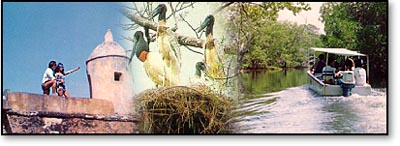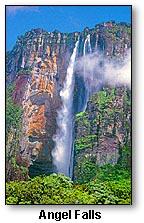
VENEZUELA
Explorations
Caracas
Situated in a valley surrounded by hills and densely forested mountain slopes, Caracas is
a sprawling, heavily populated metropolis set in the shadow of a great wilderness. Its
colonial district dates back to the 16th Century, and its museums house some of South
America's greatest works of art, particularly modern. The suburbs are also filled with
attractions; El Hatillo, to the south, is rich in colonial architecture, while to the
north of Caracas are postcard perfect beaches thick with tanned skin and Caribbean sun.
The North West
The North West of Caracas has a long history. It was the region where Columbus first
landed, and for many years towns such as Coro and Maracaibo (the 2nd most populous city
next to Caracas) traded heavily with the Netherlands Antilles. The towns are distinct in
their architecture and feel, though markedly different. Along the coast is one of
Venezuela's most treasured seashores, Parque Nacional Morrocoy. The park has excellent
beaches and numerous fine reefs for snorkeling and diving.
 Isla de Margarita
Isla de Margarita
For many Venezuelans, the ultimate vacation home is a place on the beach on
Isla de Margarita. The island is about sits about 40km off the mainland
and has a healthy
population of about 300,000. Like the nearby islands of Bonaire and Curacao,
Isla de Margarita enjoys a dry, desert climate. The capital city of Porlamar
offers just about
every modern convenience.
Andean Venezuela
People don't usually think of Venezuela when they think of the Andes, but the mountains
sweep to the East at their northern end, penetrating well into western Venezuela. The
peaks here are tall, striking, and plentiful, and they offer a full range of adventure and
sporting options. There are actually two ranges of the Andes in the region. Sitting
poetically between them is the old city of Merida, a university town with clean air and a
bohemian culture. The school here is the second oldest in South America
The North East
Venezuela's North East is where the nation's famous beaches reach their alluring heights:
this is the Venezuelan destination for the sun wor- shippers and water lovers. Mochima
National Park, a shoreline reserve of coral reefs, hundreds of islands, and beaches is one
of the most scenic stretches of tropical shoreline in South America. The capital here is
Cumana, which holds the claim of being the oldest town on the mainland.
 The Guayana Highlands
The Guayana Highlands
The south east region of Venezuela is defined by the Guayana Highlands, named after the
neighboring country to the east. Though many people have never heard of the area, many
have seen photos of its most famous landmark - Angel Falls - the world's most vertiginous
waterfall. The falls, however, are just one of many distinctive features in the area,
which is also known for the Orinoco river and also its tepuis. Tepuis are huge sandstone
mesas that rise thousands of feet about the Gran Sabana, a vast grassland.
The Amazonas
Like its name implies, the Amazonas is quite simply Venezuela's own stretch
of Amazonian rain forest. The state is one the country's largest and certainly
the most remote. It is
home to many indigenous peoples, including the Yanomami - one of the most
threatened and fragile cultures in the world. From the city of Ayacucho you
can arrange for guided tours
of the region, which abounds in flora, fauna, and cerros - the jungle's equivalent
of the tepuis
Copyright (c) 1998-2010 interKnowledge Corp. All rights reserved.
